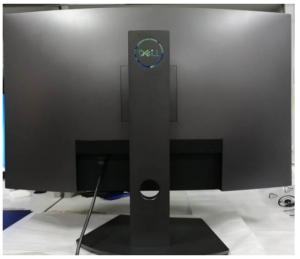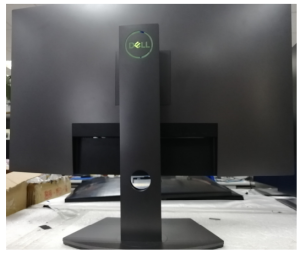Dell S3220DGF 165Hz HDR Adaptive Sync Gaming Monitor User Guide
1. Disassembly Procedures:
S1 Turn off power
S2 Unplug external cables from the product

S3 Remove the stand from the product
(No.1~4 screw size=M4x10; Torque: 12±2kgf.cm)
S5 Wedge your fingers between the rear cover and the middle bezel on the corners of the top side of the monitor to release the rear cover, then use one hand to press the middle bezel, the other hand to pull up carefully the rear cover in order of arrow preference for unlocking mechanisms of rear cover
S6 Remove the rear cover and put it on a protective cushion. Use a Philips-head screwdriver to remove 20 screws for unlocking the middle plastic bezel with the whole unit, and then remove the middle plastic bezel carefully.
(No.1~20 screw size=M3x4, Torque=3±0.5kgfxcm)
S7 Tear off 3 pieces of aluminum foil. Disconnect the lamp cable from the connectors of the power board and panel module. Use a Philips-head screwdriver to remove 3 screws for unlocking the mainframe
(No.1~3 Screw size=M3x4, Torque: 3±0.5kgf.cm)
S8 Remove the Mylar. Use a Philips-head screwdriver to remove 4 screws for unlocking the mainboard and the adapter board
(No.1~8 screw size=D3x6, Torque: 6±1kgf.cm)
(No.9 screw size=M4x6, Torque: 6±1kgf.cm)
S9 Disconnect all of the cables.
The Mainframe |
S10 Use a Philips-head screwdriver to remove 1 screw to remove the USB board. Disconnect the cables of the USB board
(No.1 screw size=M3x6, Torque=4±1kgf.cm)
S11 Use a Philips-head screwdriver to remove 5 screws for unlocking the BEZEL_BTM and the Panel.
(No.1~5 screw size=M3x3, Torque=3±0.5kgf.cm)
The Panel |
S12 Use a Philips-head screwdriver to remove 4 screws for unlocking the keyboard and the middle frame.
Disconnect the pin.
(No.1~4 screw size=Q2x2.5, Torque=0.9±0.4kgf.cm)
S13 Remove electrolyte capacitors (red mark) from printed circuit boards
Take out the bulk cap. Pins older with soldering iron and absorber.
Lift the bulk cap. up and away from the PCB
2. Product material information
The following substances, preparations, or components should be disposed of or recovered separately from other WEEE in compliance with Article 4 of EU Council Directive 75/442/EEC.
| Capacitors / condensers (containing PCB/PCT) | No used |
| Mercury-containing components | No used |
| Batteries | No used |
| Printed circuit boards (with a surface greater than 10 square cm) | The product has printed circuit boards (with a surface greater than 10 square cm) |
| The component contains toner, ink, and liquids | No used |
| Plastic containing BFR | No used |
| Component and waste contain asbestos | No used |
| CRT | No used |
| Component contain CFC, HCFC, HFC and HC | No used |
| Gas discharge lamps | No used |
| LCD display > 100 cm2 | The product has an LCD greater than 100 cm2 |
| External electric cable | The product has external cables |
| The component contains refractory ceramic fibers | No used |
| The component contains radioactive substances | No used |
| Electrolyte capacitors (height > 25mm, diameter > 25mm) | Product has electrolyte capacitors (height > 25mm, diameter > 25mm) |
3. Tools Required
List the type and size of the tools that would typically be used to disassemble the product to a point where components and materials requiring selective treatment can be removed.
Tool Description:
- Screwdriver (Phillip head) #1
- Screwdriver (Phillip head) #2
- Penknife
- Soldering iron and absorber